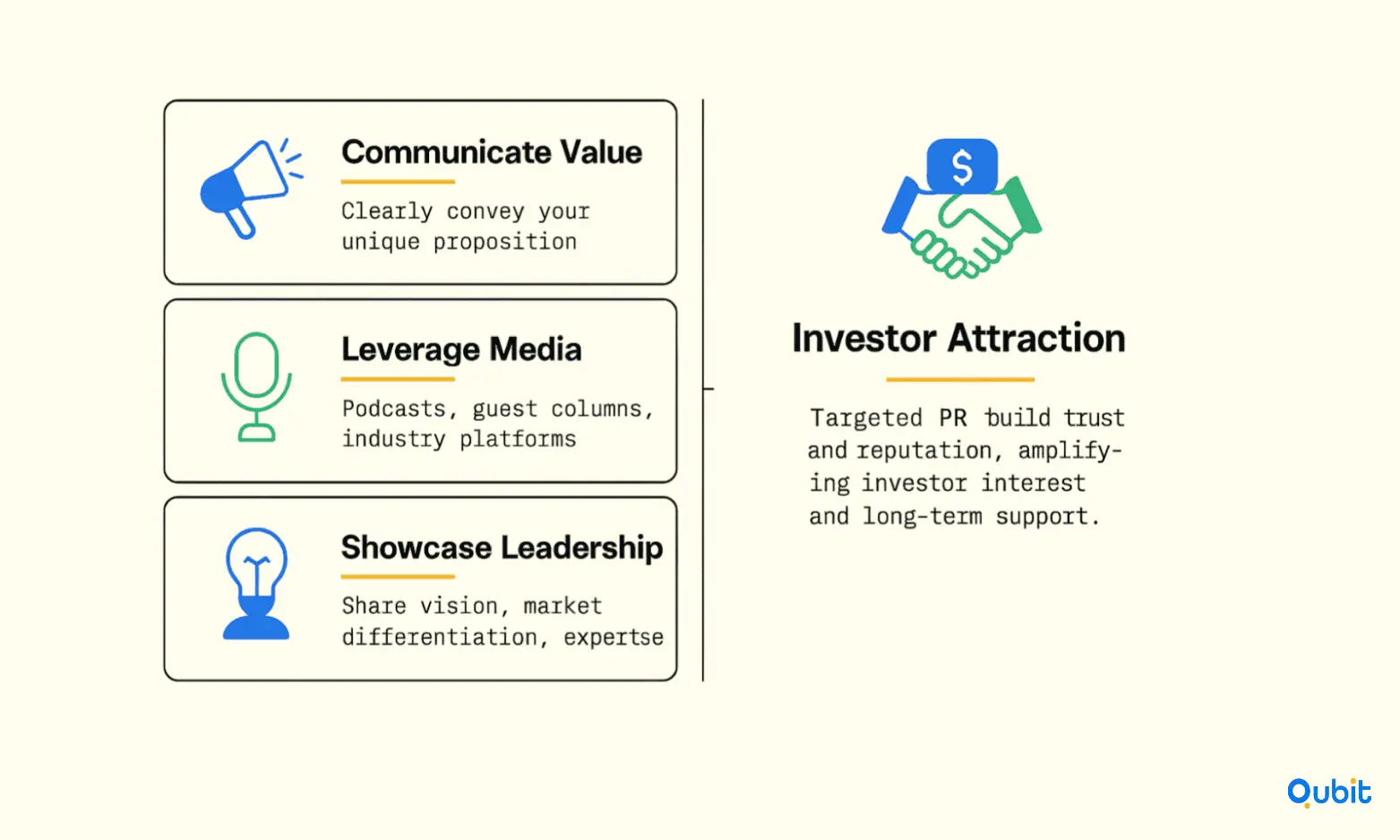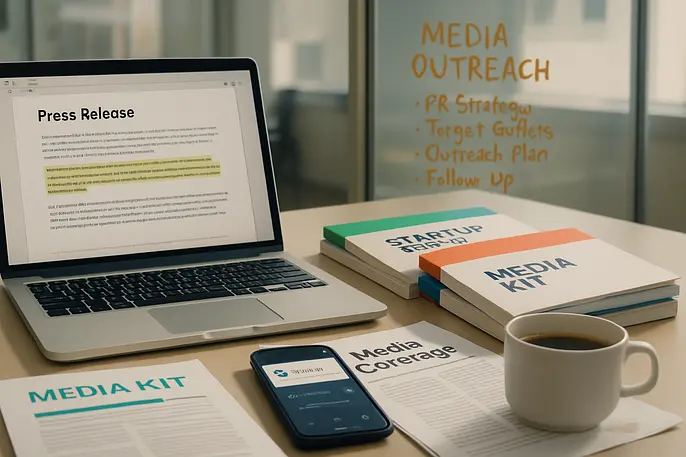Founders do not pitch the best investors first. They pitch the most visible ones first. If your firm is hard to find, hard to understand, or easy to confuse with everyone else, top startups will pass you by without even realizing it.
PR and media outreach is how you fix that. It is not about vanity headlines. It is about building credibility at scale, so the right founders already trust you before the first call. That matters even more because most firms still do not show up consistently online. Only about 10% VC have a solid content strategy, while most post sporadically or not at all.
This guide is for investors and VC teams who want to use PR, earned media, and thought leadership to attract higher-quality inbound startups, without sounding like a walking press release.
Effective PR and Media Outreach for Building Credibility and Attracting Investment
Standing out in the competitive funding landscape requires more than just a great product or service. To attract high-quality startups, investors should focus on strategic PR: sharing credible stories, building media relationships, and leveraging targeted channels. Early, transparent communication builds trust.
Startups must effectively communicate their unique value propositions to capture the attention of potential investors. A well-executed public relations (PR) strategy can be the bridge that connects your brand with the right audience.

Robust PR efforts not only enhance brand reputation but also foster trust—two critical factors for attracting investment. Startups can use podcasts and guest columns to showcase expertise. Founders share visions and highlight their commitment to solving real-world problems.
Be wary of overexposing your startup, as negative press can arise. Also, ensure that PR efforts are aligned with regulatory guidelines for investor communications.
Research has shown that media coverage impact research can significantly amplify a startup’s visibility and credibility. For instance, StartupNation emphasizes the importance of media exposure in building a strong foundation for growth. This kind of exposure can validate your business in the eyes of investors, making them more likely to engage.
Financial visibility also drives investment outcomes. During a recent review period, monetary contribution of visitors and students rose to $18.4 billion. This increase underscores the real value of heightened public and brand engagement, reinforcing why robust PR boosts perceived company worth.
Ultimately, PR is not just about visibility; it’s about creating a narrative that resonates with stakeholders. By strategically positioning your brand through targeted media channels, you can build a reputation that attracts not only investors but also long-term advocates for your business.
To gain a broader contextual perspective, explore how to do startup outreach for investors, which provides a foundational backdrop to this detailed guide. By understanding the nuances of outreach, you can position yourself as a trusted partner in the startup ecosystem.
Market-Oriented PR Strategies
Understanding your audience is the cornerstone of impactful PR and media outreach. Tailoring your messaging to align with market preferences ensures that your efforts resonate. Use press releases, personalized pitches, or dynamic social media campaigns.
Identifying these preferences allows brands to craft narratives that not only capture attention but also foster meaningful engagement.
Press releases remain a powerful tool for generating media visibility, especially when they highlight stories that align with audience interests. For instance, an example of media visibility attracting investors demonstrates how strategic branding can elevate a startup’s appeal to potential backers. Similarly, targeted pitches to journalists or influencers can amplify your reach by connecting with individuals who already have the trust of your desired audience.
Social media campaigns, when executed with precision, can create a buzz that drives both awareness and action. By analyzing audience behavior and preferences, brands can design campaigns that feel authentic and relevant, fostering stronger connections with their followers.
For businesses looking to refine their PR strategies, exploring effective outreach channels for investors can provide actionable insights that complement these methods. Thoughtful alignment of messaging with market needs not only boosts visibility but also builds lasting relationships with stakeholders.
Core Elements of a Robust PR and Media Outreach Strategy
Building a successful PR strategy requires a thoughtful approach that combines clear objectives, audience insights, and consistent messaging. Each element plays a critical role in shaping how a brand communicates and connects with its audience. Below, we explore the foundational aspects that ensure a PR campaign stands out and delivers measurable results.
1. Define Clear Goals
Every effective PR strategy begins with well-defined goals. Whether the aim is to increase brand awareness, manage reputation, or drive engagement, setting specific and measurable objectives provides direction. For instance, a goal like “achieving a 20% increase in media mentions within six months” offers a clear benchmark for success. Without such clarity, efforts can become scattered, making it difficult to evaluate outcomes.
Align your PR goals with macro trends. For example, permanent economic immigration is projected to reach 64% of Canada's total immigration soon. This shift signals increased competition for talent and investors, motivating sharper PR campaigns that clearly communicate goals.
2. Align PR Messaging with Growth Stage and KPIs
Building on clear goal-setting, aligning PR messaging with your startup’s current growth stage and key business metrics is essential. This approach ensures communications accurately reflect progress and address what matters most to investors. Tailored messaging based on real milestones and KPIs enhances credibility, making outreach more persuasive. Integrating this alignment into your strategy supports trust and relevance throughout each funding cycle.
3. Build Strong Media Relations
Establishing and maintaining quality relationships with media professionals is another cornerstone of a robust PR strategy. Journalists, bloggers, and influencers act as amplifiers for your brand's story. By offering them timely, relevant, and newsworthy content, you increase the likelihood of positive coverage. Strong media relations also help in crisis situations, where trusted connections can ensure your side of the story is heard.
4. Prepare a Comprehensive Media Kit
Beyond building relationships, preparing a comprehensive media kit streamlines your outreach to journalists and investors. A well-organized kit typically includes press releases, company background, founder bios, and high-quality visuals. This resource ensures your messaging remains consistent and accessible, making it easier for media and investors to understand your story. Investing in a media kit supports professional, efficient communication.
5. Maintain Consistent Content Creation
Consistency in content creation is vital for sustaining audience engagement. Regularly publishing high-quality content, whether through blogs, press releases, or social media—keeps your brand top-of-mind. This approach not only supports your PR goals but also complements broader marketing efforts. Observations on content marketing for investors offer a nuanced look into how content can serve as a reliable means of connecting with startups within the broader strategy.
6. Plan for Crisis Management in PR
Completing your PR strategy, proactive crisis management planning is vital for protecting your reputation and investor confidence. Anticipating potential issues allows you to respond swiftly and transparently if challenges arise. Developing clear protocols and messaging in advance minimizes confusion and helps maintain trust. Including crisis planning ensures your PR approach remains resilient under pressure.
Measuring and Optimizing PR Impact
Tracking the success of public relations efforts begins with identifying measurable indicators. Metrics such as media mentions, social engagement, and website traffic provide tangible insights into campaign performance. Monitoring these key performance indicators (KPIs) regularly helps pinpoint areas of strength and opportunities for improvement.
Data-driven feedback loops play a crucial role in refining PR strategies. By analyzing trends and outcomes, teams can adjust messaging, timing, and outreach methods to better align with audience preferences. This iterative approach ensures campaigns remain relevant and impactful over time.
For organizations aiming to maximize PR effectiveness, integrating analytics tools and setting clear benchmarks can streamline the optimization process.
Structured Implementation: 9-Step PR Campaign Plan
Crafting a PR and media outreach campaign that resonates with stakeholders requires a structured, step-by-step approach.
1. Define Clear Objectives
Start by identifying the specific goals of your PR campaign. Are you aiming to attract investors, boost brand visibility, or launch a new product? Defining measurable objectives ensures that every subsequent step aligns with your overarching vision. For example, if your goal is to attract startups, incorporating innovative strategies like investor virtual office hours can add depth to your outreach methods.
2. Understand Your Audience
A successful campaign hinges on knowing your audience. Conduct thorough research to understand their preferences, pain points, and communication channels. Whether your target is investors, customers, or industry peers, tailoring your messaging to their needs enhances engagement and trust.
3. Craft a Compelling Narrative
Your campaign’s story is its backbone. Develop a narrative that highlights your brand’s unique value proposition while addressing audience concerns. A well-crafted story not only captures attention but also builds emotional connections, making your campaign memorable.
4. Select the Right Channels
Choosing the appropriate communication channels is critical. Social media, press releases, webinars, and email campaigns each serve distinct purposes. Evaluate which platforms your audience frequents and prioritize those for maximum impact.
5. Develop a Detailed Timeline
A timeline keeps your campaign organized and ensures timely execution. Break down tasks into manageable phases, assigning deadlines and responsibilities to each. This structure minimizes delays and keeps the campaign on track.
6. Create Engaging Content
Content is the lifeblood of any PR campaign. From blog posts to videos, ensure your materials are informative, engaging, and shareable. High-quality content not only attracts attention but also encourages audience interaction, amplifying your campaign’s reach.
7. Implement Iterative Feedback Loops
Feedback is invaluable for refining your campaign. At each stage, seek input from stakeholders and adjust your strategy accordingly. This iterative process ensures continuous improvement and adaptability to unforeseen challenges.
8. Monitor Performance Metrics
Tracking performance metrics allows you to measure the success of your campaign. Use tools to analyze engagement, conversion rates, and audience sentiment. These insights help identify areas for improvement and validate your efforts.
9. Reflect and Optimize
Once the campaign concludes, evaluate its outcomes against your initial objectives. Identify what worked well and what could be improved. Use these insights to optimize future campaigns, ensuring sustained growth and success.
By following this structured plan, you can create PR campaigns that not only meet but exceed investor expectations.
Investor PR: Enhancing Visibility and Credibility
Building trust with investors requires a thoughtful approach that prioritizes transparency and engagement. Tailored PR strategies can address the specific needs of potential investors, focusing on their due diligence and trust-building requirements. A multi-touch strategy—using multiple coordinated channels and touchpoints for communication—is particularly effective, combining social media presence, networking events, and thought leadership initiatives to amplify visibility and establish credibility.
Social media platforms offer a direct channel to showcase achievements, share updates, and engage with investor communities. Networking events, whether virtual or in-person, provide opportunities to foster relationships and demonstrate expertise. Meanwhile, thought leadership—through articles, interviews, or webinars—positions your brand as a reliable authority in the industry.
By integrating these methods, businesses can create a cohesive narrative that resonates with investors, ensuring they feel informed and confident in their decision-making process.
Conclusion
Founders do not chase the best investors. They chase the most visible and easiest-to-trust investors. PR and earned media fix that by turning your firm into a clear, credible brand founders recognize before the first call. The winning play is simple and boring in the best way. Pick a tight narrative, publish consistently, build real journalist relationships, and measure what actually moves inbound quality. Do that, and you stop competing on “who you know” and start winning on “who founders already believe.”
If you're ready to build credibility and attract high-quality startups, we invite you to explore our Startup Scouting service and elevate your investor PR campaigns.
Key takeaways
- Robust PR strategies build investor trust and enhance brand credibility.
- Data-driven insights and measurable KPIs are essential for optimizing outreach.
- A structured 9-step campaign plan can streamline PR implementation.
- Targeted messaging and tailored content are key to attracting high-quality startups.
- A dedicated investor hub online minimizes friction and ensures immediate access to vital information.
Frequently asked Questions
How do startup PR outreach strategies help attract high-quality startups?
Startup PR outreach strategies help investors build credibility and visibility, making them attractive to high-quality startups seeking reputable funding partners.






